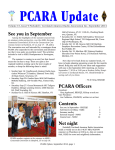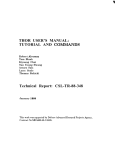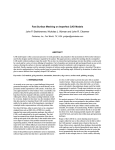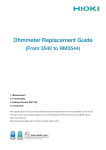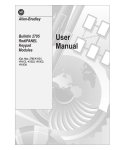Download Druck DPI 260 Series Digital Pressure Indicator User Manual K048
Transcript
i Druck DPI 260 Series Digital Pressure Indicator User Manual K048 © Druck Limited 1995 This document is the property of Druck Limited and may not be copied or otherwise reproduced, communicated in any way to third parties, nor stored in any Data Processing System without the express written authorisation of Druck Limited. K048 Issue No. 6 ii K048 Issue No. 6 iii Contents Section 1 2 3 Page Introduction ................................................. 1 Specification ................................................ 2 Installation ................................................... 3 Panel Cut-out ................................................................. 3 Power Supply ................................................................ 3 D.C. Power Option ........................................................ 4 Electrical connection ..................................................... 5 Pressure connection ..................................................... 6 Cleaning ......................................................................... 6 4 Operation ...................................................... 7 5 Calibration .................................................... 7 Zero ................................................................................ 7 Span ............................................................................... 7 6 Setting-up ..................................................... 9 Coarse zero adjustment ................................................ 9 Coarse span adjustment ............................................... 9 Display over-range setting .......................................... 10 Linearity ....................................................................... 10 Decimal point position ................................................. 10 Bridge supply ............................................................... 11 DPI 262 Pre-amplifier .................................................. 11 Remote power supply sense ....................................... 11 7 Options ....................................................... 12 12 V d.c.power supply ................................................. 12 28 V d.c. power supply ................................................ 12 Analogue Output ......................................................... 12 Buffered Output ................................................... 12 Voltage Output ..................................................... 12 Current Output ..................................................... 12 Output Offset ....................................................... 12 Multiplexed BCD output .............................................. 13 Control Input ................................................................ 13 Remote Displays ......................................................... 14 Parallel BCD output ..................................................... 14 Hold Input .................................................................... 16 8 Fault Finding .............................................. 20 K048 Issue No. 6 iv Safety The manufacturer has designed this equipment to be safe when operated using the procedures detailed in this manual. The user must not use this equipment for any other purpose than that stated. Do not apply values greater than the maximum value stated. This manual contains operating and safety instructions which must be followed to ensure the safe operation and to maintain the equipment in a safe condition. The safety instructions are either warnings or cautions issued to protect the user and the equipment from injury or damage. Use qualified* personnel and good engineering practice for all procedures in this manual. *A qualified person must have attended a product training course given by the manufacturer or appointed agent and successfully completed the training course on this equipment. K048 Issue No. 6 v Symbols and markings This product meets the essential protection requirements of the relevant EEC directives. Further details of applied standards may be found in the product specification. This symbol, on the instrument, indicates that the user should refer to the user manual. K048 Issue No. 6 vi Abbreviations The following abbreviations are used in this manual. Note: Abbreviations are the same in the singular and the plural. ac alternating current BCD binary coded decimal °C degrees Celsius dc direct current DIN Deutsche Industrie Norm EOC end of conversion FS full-scale FSD full-scale deflection HBC high breaking current Hz Hertz LK link mA milli Ampere max maximum min minimum/minute mm millimetre MΩ mega Ohm MSB most significant bit mV millivolt -ve negative Ω Ohm PCB printed circuit board +ve positive rms root mean square RV potentiometer (variable resistor) sec second SW switch TTL transistor/transistor logic V Volt VA Volt Ampere K048 Issue No. 6 1 Introduction The Druck DPI 260 Series of instruments are generalpurpose pressure indicators that measure and display pressure in specific pressure units with accuracies of ±0.1% FS or ±0.04% FS. The pressure sensor can be an internally or externally fitted transducer or an externally fitted transmitter. Internal switches allow for 10 to 200 mV FSD input, zero adjustment of ±19999 and decimal point selection. The transducer excitation voltage of either -5 V or -10 V can be selected by links on the bridge supply circuit with a maximum load of 350 Ω. The transmitter supply is also selected by links to an unregulated +20 Volts (17.5 to 30 Volts) with a maximum current of 20 mA. Linearization for square law is incorporated via the supply. An over-range warning can be set to any pressure. A range of plug-in, retrofit digital and analogue output options are available. The power supply can be 120 or 240 V a.c. (selected by link) or an option of 28 V d.c. or 12 V d.c. 1 K048 Issue No. 6 2 Specification Electrical safety ................... meets EN61010-1 as applicable Power supply ................................................... 110 or 240 V ................................................... 50 to 400 Hz ............................................ 3 VA (maximum) Electromagnetic compatibility ...................... meets EN50081-1 (emissions) ........................ meets EN50082-1 (immunity) Operating temperature range ................. Combined non-linearity, repeatability °0 to 50°C hysteresis and DPI 260 ±0.1% F.S., ±0.5% TEB ............ (to 60 bar) DPI 261 ±0.04% F.S., ±0.005%/°C/TC ....... (to 35 bar) DPI 262 ±0.1% F.S. ................................. (to 700 bar) See data sheet for full details K048 Issue No. 6 2 3 Installation 3.1 Panel Cutout To fit the unit in a panel requires a mounted DIN standard 92 x 45 mm cut-out. Locate the instrument in the panel and secure with the case fixings from the front panel screws. 3.2 Power Supply WARNING Voltages in excess of 30 V (RMS) a.c. or 50 V d.c. can, in certain circumstances, be lethal. Care must be taken when working on live, exposed conductors. CAUTION: Identify the operating Voltage before connecting the instrument. AC powered instruments have black 3-core cables that must be connected: Brown Blue Green/Yellow - Live Neutral Earth WARNING Disconnect the power supply before removing the instrument covers, live Voltages are present. 3 K048 Issue No. 6 An internal link selects a nominal 120 or 240 V a.c. the operating limits are: 200-260 V a.c. 50-400Hz (Link P6/P7) 100-130 V a.c. 50-400Hz (Link P4/P7,P5/P6) Electrical safety To comply with electrical safety standards, the label showing the operating Voltage MUST be changed when the Voltage setting is changed. An internal 500 mA 20 mm fuse is fitted in the live circuit. 3.3 DC Power Option DC powered instruments have white 2-core cables that must be connected: Brown Blue The operating limits are: +12V or +28V 0V 10 - 14V d.c. at 300 mA (G option) 20 - 32V d.c. at 150 mA (H option) An internal 500 mA 20 mm fuse is fitted in the positive circuit. Fuse replacement Only replace the internal fuse (a.c. or d.c.) with a ceramic HBC, F type fuse. K048 Issue No. 6 4 3.4 Electrical Connection 1 2 3 4 SENSE (OPTIONAL) 0V SCREEN - SUPPLY - SIGNAL + SUPPLY + SIGNAL For DPI 260/261 external transducers are connected to a 6-pole connector (Figure 1). 5 6 CONNECTOR GREENPAR RM12 BPG-6P Transducer Figure 1 External Connections (DPI 260, 261) The DPI 262 transmitter circuit terminates at a 6-pole connector (Figure 2). 6 1 3 PCB CONNECTOR TRANSMITTER INTERFACE PCB 0va 2 BLUE 5 100Ω ⊗ 1 RED 3 ⊗ 4 5 SCREEN ⊗ 2 SIGNAL (20 V) SUPPLY 4 6 CONNECTOR GREENPAR RM12 BPG-6P Transmitter Figure 2 External Transmitter Connections (DPI 262) 5 K048 Issue No. 6 3.5 Pressure Connection ! For gauge and absolute transducers a single pressure port is marked "+". Various fittings are available, (see data sheet). ! For differential transducers the additional port is marked “-”. The maximum line pressure of 2 bar must not be exceeded. 3.6 Cleaning ! Clean the instrument case with a damp cloth and mild detergent. K048 Issue No. 6 6 4 Operation The display shows the pressure applied to the sensor (transducer or transmitter) in the units of pressure measurement shown on the front panel. The zero pressure setting can adjusted to increase or decrease the reading. If the pressure reading exceeds the preset maximum value (setting from 1999 to 19999) the display shows a flashing 0000. 5 Calibration Routine calibration adjustments should be made at periods of 6 months, this period may be changed depending on the frequency of use. Use an accurate pressure standard to apply pressure and, if necessary, adjust the instrument. Allow a warm-up time of approximately 1 hour. 5.1 Zero The zero adjustment is made using the 20-turn potentiometer accessed through the front panel. For gauge instruments make sure no pressure is applied. For absolute instruments, apply a vacuum to the transducer before adjustment. To prevent unauthorised adjustments fit a sealing label over the potentiometer access on the front panel. 5.2 Span The span adjustment for the full-scale pressure value is made using the 20-turn span potentiometer accessed through the front panel. Connect the pressure standard to the instrument and adjust to the full-scale value. To prevent unauthorised adjustments fit a sealing label over the potentiometer access on the front panel. 7 K048 Issue No. 6 OFF DIGITAL OPTION NO OPTION LINK LK1 RV3 R3 SET ZERO SWZ LK4 (5V) + PRESS TO OPEN SET OVER-RANGE P5 P6 P7 P8 OR 120V a.c. LK2 L N E 240V a.c. TRANSFORMER IC1 RV2 R1 R4 6 5 4 3 2 1 12V DC - DC CONVERTER REPLACED BY R2 FOR DPI 262 LK7 LK6 LK3 (20V)(10V) SENSE SUPPLY SELECT (LK7 FOR DPI 262) 500 mA 20mm FUSE POWER SUPPLY LEAD EARTH/ GROUND TRANSDUCER OR TRANSMITTER PCB (DPI 262) Figure 3 Internal Layout ANALOGUE OPTION SET SPAN SWS - ON DECIMAL POINT SELECT SWD RV6 RV7 LK5 PRESS TO OPEN SET LINEARITY R2 8 K048 Issue No. 6 ZERO SPAN LK8 X10 GAIN SELECT SET SUPPLY RV5 PRESS TO CLOSE 5 6 7 8 1 2 3 4 PRESS TO CLOSE 1 2 3 4 5 6 7 8 RV4 6 5 4 3 2 1 6 Setting-up (Figure 3) The DPI 260 Series of instruments can be configured for other applications including zero and span settings. 6.1 Coarse Zero Adjustment If a zero display is required for applied pressure other than zero pressure an offset of ±19999 can be selected by using the set zero switches SWZ on the PCB. Apply the required pressure for zero and when stable select open all the SWZ switches. If the pressure reading is positive close switch 1, if negative close switch 2. Close, in turn, switches 3 to 8 open the switch if the reading overshoots zero. Using the zero calibration procedure adjust the reading to read exactly zero. The suppression of 4mA in the DPI 262 instrument is achieved by this method by closing switches 1 to 7. Using the zero calibration procedure, adjust the reading to exactly zero. 6.2 Coarse Span Adjustment The instrument can be set to read a "full-scale" reading value up to 19999 for a transducer input of the range 10 to 200mV. Set the zero adjustment first, then using the span set switches SWS set the required full-scale value. Close all the SWS switches and apply the required full-scale pressure. If the reading is too high, remove link LK8. Open, in turn, the switches 1 to 8, close a switch again if the reading over-shoots the required reading. Using the routine span procedure, adjust the reading to the exact full-scale value. 9 K048 Issue No. 6 6.3 Display Over-Range Setting The over-range condition (flashing 0000) can be set to occur at any reading in the range 1999 to 19999. To avoid this setting conflicting with the span setting, turn potentiometer RV3 fully anti-clockwise (20 turns). Apply the required over-range pressure or temporarily close switches on SWZ. Adjust the potentiometer RV3 clockwise until the display flashes. Reduce the pressure or reset the switches on SWZ. 6.4 Linearity RV4 controls feedback between the amplified transducer signal and the bridge excitation supply and affects the correction for square law non-linearity. Removing LK5 stops linearization feedback. The following procedure only applies to transducers where zero pressure equates to zero nominal output from the transducer. Note: For other applications refer to Druck. ! Remove LK5, carry out a zero and span calibration. ! Apply half-scale pressure and note the error. ! Apply full-scale pressure and insert LK5. ! Adjust potentiometer RV4 until the reading equals full-scale plus 4 times the error (e.g., if the midpoint is 3 counts low then adjust the reading to [full-scale - 12 counts]). 6.5 Decimal Point Selection SWD is used to select the position of the displayed decimal point K048 Issue No. 6 10 6.6 Bridge Supply The supply is nominally -10V at zero pressure or -5V if LK4 is inserted. Potentiometer RV5 adjusts the voltage ±5%. In the DPI 262 instrument LK6 is removed and LK7 inserted, this changes the supply to an unregulated +20V (17.5 to 30V) for loop power. 6.7 DPI 262 Pre-amplifier IC1 and the matched resistors R1, R2, R3 and R4 provide a high-accuracy, differential pre-amplifier with a gain of 50 for transducers. Resistor R3 is replaced by R2 creating a single-ended, unity gain amplifier. A small plug-in PCB in the transducer connector contains a 100Ω sense resistor which is connected between SIGNAL+ and 0V. This provides a signal of 0.4 to 2V for 4 to 20mA. The 0.4V is adjusted by SWZ (see coarse zero adjustment) the span is adjusted by SWS (see coarse span adjustment). 6.8 Remote Power Supply Sense By removing LK3 the sensing circuit for the bridge supply can be remotely connected via the transducer external connector pin 6. The sense input impedance is 20kΩ. 11 K048 Issue No. 6 7 OPTIONS 7.1 12V D.C. Power Supply (option G) The a.c. power supply circuit is replaced by a DC to DC convertor that generates ±20V, the 12V supply is regulated providing a +5V supply. To identify the option a white supply cable is fitted. 7.2 28V D.C. Power Supply (option H) The a.c. power supply circuit is replaced by a DC to DC convertor that generates ±28V, the 28V supply is regulated providing a +5V supply. To identify the option a white supply cable is fitted. 7.3 Analogue Output This option is normally installed at manufacture but can be retro-fitted by Druck or by the user. A plug-in PCB assembly can be configured to produce, via a 25way connector (Figures 4 and 6) one of the following: 7.4 Buffered Output (option C) A unity gain buffer produces the instrument reading as a voltage with minimum errors (19999 = 2V). 7.5 Voltage Output (option D) This amplifies the display voltage to an output voltage 10V max. 7.6 Current Output (option E and F) The plug-in PCB can be configured so that Pin 13 and Pin 25 on the 25-way connector (Figure 4 or 6) sinks current (option E). The sink current depends on the output voltage established by the buffered or Voltage output options (maximum 16 mA or 80 mA respectively). K048 Issue No. 6 12 Pin 25 can be configured (option F) by links: ! LK6 - 0V for external loop supply. ! LK7 - 15V for power external loop. ! LK8 - unregulated +17 to +30V to power loop. 7.7 Output Offset The output (voltage or current) can be offset by inserting links and a resistor. RV1 is used to fine adjust the offset. A positive offset is used to generate 4mA at zero pressure reading. 7.8 Multiplexed BCD Output (option B) The data interface consists of: ! 4 information lines for the BCD data ! 4 address lines to indicate digit ! 1 clock line to indicate new data valid ! 1 signal ground reference The instrument converts the input analogue signal to a digital format. The conversion cycle is continuously repeated, see Figure 5. All information lines are capable of driving one TTL load. 7.9 Control Input The HOLD input stops further conversion cycles when connected to signal ground. Conversion starts when the HOLD state is at 5 Volts or is an open circuit. The ENABLE input allows output to take place. The instrument can be configured for the ENABLE input state to become active +5 Volts or at open circuit. This allows up to ten instruments to transmit data over a shared data bus. 13 K048 Issue No. 6 0 VOLT LOGIC EOC/DATA CLOCK BCD1 BCD4 1 2 3 4 5 D1 6 D3 SPARE 7 8 SPARE SPARE SPARE 9 10 11 SPARE SPARE 12 13 ANALOGUE SIGNAL 4 - 20 mA (SINK) 14 ENABLE 15 HOLD 16 BCD2 17 BCD8 18 D2 19 D4 20 SPARE 21 SPARE 22 SPARE 23 SPARE 24 SPARE 25 0V ANALOGUE/ 4 - 20 mA (POWER) Figure 4 Multiplexed BCD 25-way Connector 7.10 Remote Displays (figure 5) The digit lines can select the remote display digits and the BCD lines decoded to a seven-segment drive form. The Druck DPI 110 unit is supplied as a remote display. 7.11 Parallel BCD Output (option A) The BCD information is available on 25-way “D” connector. The information is presented as: ! ! 4 decades of 4 bits (representing values 8,4,2,1 in positive logic). 1 bit for MSD (`1' indicates active MSD ). ! 1 bit for POLARITY (`1' indicates negative value). ! 1 bit for OVER RANGE (`1' indicates input signal greater than 19999). K048 Issue No. 6 14 DATA CLOCK HOLD (ON CONVERSION) X NEXT CONVERSION STARTS (IF FREE RUNNING) 0.45S approx 300nS MIN X X DATA CLOCK EXPANDED 20mS 4µS approx 1.0mS OUTPUT 1 2 3 4 5 BCD8 BCD4 BCD2 BCD1 DIGIT 1 DIGIT 2 DIGIT 3 DIGIT 4 1 1 THOUSANDS HUNDREDS TENS UNITS approx 0 1 0 0 0 0 1 0 0 0 0 1 0=+ 0=- MSD 0 0 0 0 1 0 0 0 1 1 0=+ 0=- ETC 0 0 0 0 X Figure 5 Multiplexed BCD Timing diagram 15 K048 Issue No. 6 Each signal is capable of driving up to five TTL loads. The information conversion cycle is approximately 400 milliseconds with a short period, approximately 10 milliseconds at the end of each cycle, when the data output is updated. This update period is indicated by the DATA VALID signal `0'. The updated data is available when the DATA VALID signal returns to `1'. 7.12 Hold Input The HOLD input stops further conversion cycles when connected to signal ground. Conversion starts when the HOLD state is at `1' or is an open circuit; the data flow is free running, see figure 7. The HOLD input (at `0') latches the data output, the display continues to update each measurement cycle. A short pulse (>300 nano second) starts an update indicated by a pulse of the DATA VALID output. Note: A single trigger mode is not recommended. 0 VOLT LOGIC POLARITY BCD1 x 100 BCD4 x 100 1 1 2 3 4 5 BCD1 x 10 BCD4 x 101 2 BCD1 x 10 BCD4 x 102 BCD1 x 103 3 BCD4 x 10 MSD1 x 104 OVER-RANGE 6 7 8 9 10 11 12 13 ANALOGUE SIGNAL 4 - 20 mA (SINK) 14 HOLD 15 DATA VALID 16 BCD2 x 100 17 BCD8 x 100 18 BCD2 x 101 19 BCD8 x 101 20 BCD2 x 10 21 BCD8 x 102 22 BCD2 x 103 23 BCD8 x 10 24 MSD2 x 104 25 0V ANALOGUE/ 4 - 20 mA (POWER) 2 3 Figure 6 Parallel BCD 25-way Connector K048 Issue No. 6 16 DATA VALID DATA DATA 1 HOLD 400mS DATA 3 END CONVERSION HOLD 400mS DV = 0 WHEN HOLD >300nS TRIGGER/HOLD HOLD = ‘1’ ALLOWS UPDATE AT NEXT END OF CONVERSION END CONVERSION DATA 4 K048 Issue No. 6 17 END CONVERSION 10 mS DV = 0 WHEN HOLD DATA 2 Dv = AS HOLD CHANGED TO ‘0’ DATA UPDATED AT END OF 400mS NO FURTHER UPDATE UNTIL HOLD = ‘1’ DATA 2 FREE RUNNING EACH 400mS DATA UPDATED Dv PULSES TO‘0’ Fig 7 Parallel BCD Data Update Timing 8 FAULT FINDING In the event of a malfunction instruments can be returned to the Druck Service Department or Druck agent for rectification. The following fault finding procedures in Table 1 must be carried out by qualified* personnel using good engineering practise. Make sure power supply is disconnected from the instrument before accessing internal components. * see the safety page (i) Table 1 Fault Finding FAULT ACTION/CAUSE No display 1. CHECK power supply switched on. 2. CHECK power supply fuse. 3. CHECK power cable. 4. CHECK internal 500mA fuse. 5. REPLACE power supply module. 6. REPLACE display PCB failure. Flashing display OVER-RANGE CONDITION 1. REDUCE applied pressure. 2. CHANGE over-range setting. Unstable display 1. CHECK applied pressure. 2. CHECK stability of power supply. 3. CHECK for electromagnetic interference near the instrument and power supply. 4. CHECK cable on external sensors. 5. CALIBRATE instrument. 6. REPLACE pressure sensor. K048 Issue No. 6 18
























